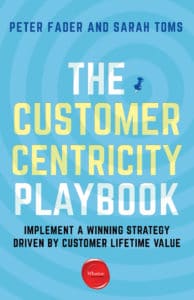Excerpted from The Customer Centricity Playbook: Implement a Winning Strategy Driven by Customer Lifetime Value, reprinted by permission of Wharton Digital Press.
How did Best Buy go from life support to become a rare big-box store success story? How did Electronic Arts clear a billion dollars in profit? How did Amazon become the titan it is today? Each company followed a customer-centric strategy.
Customer centricity begins by recognizing that customers are not all the same. They are a heterogeneous group: some will provide substantial lifetime value, while others will yield only short-term rewards. Determining who the best customers are, and launching an acquisition, retention, and development strategy geared toward them is crucial to any business operating in today’s marketplace.
Transitioning from a product-centric approach to a customer-centric one can be a challenge and even some of the smartest companies can fall prey to common pitfalls.
Here are five of the most common mistakes we’ve seen and some tips for avoiding them.
Mistake #1: Failing to Optimize Around Customer Lifetime Value
Customer lifetime value (CLV) is critical for developing a customer-centric strategy. CLV is a forward-looking, predictive measure that is at the heart of determining who your best, mediocre, and worst customers are. By measuring CLVs, firms gain an advantage through the invaluable insights about how particular customers are likely to behave in response to their products and services. Remembering that no matter how hard you try, not all customers can, or will, have high CLV, firms can leverage CLV to tune their acquisition, retention, and development strategies in ways that appeal to the specific type of customer (high, medium, low value).

Our advice is to start running experiments to test the effectiveness of your marketing, sales, and customer service efforts in relation to the varying CLVs.
Mistake #2: Relying on Antiquated Demographics to Understand Customers
For decades, marketing was all about demographics. Not because demographics were all that great for understanding your customers—they weren’t—but because demographics were what marketers could get their hands on. Every time you hear about a marketing strategy targeting, say, the 18–34 male sector, that’s demographic thinking at work. Not only is it a poor way to drive an effective acquisition strategy, but even for existing customers, it’s relatively unusual to find demographic segments that cleanly separate customers in terms of CLV. Demographics are an outmoded way of understanding your customers and don’t give you a grip on who your best customers are.
CLV is a far better measure to use when trying to understand customer diversity.
Usually, the variability in CLV across customers within a demographic bucket is far greater than the mean differences across buckets. Sure, the CLV across buyers in a particular category may be higher for, say, older people versus younger people, but these differences—even if statistically significant—are relatively inconsequential compared with the vast differences within each group.
Mistake #3: Failing to Appreciate How Branding Relates to Customer Centricity
Branding is a powerful component of an effective customer-centric strategy. But it’s hard to measure the effects of a strong brand on its own because it is deeply intertwined with the other, more tangible aspects of customer centricity (e.g., acquisition, retention, and development). Indeed, a firm’s brand will make the success of such tactics easier to achieve, and more impactful than they would be without the helping hand that a strong brand lends.
Put another way, we see branding as the lubrication for the customer centricity engine—making all the different aspects of the customer-centric tactics work better.
But while the brand plays an invaluable role in customer centricity, it is also extremely difficult to formally quantify its effects. It’s much harder to calculate “brand equity” than “customer equity (i.e., the sum of the CLVs across a customer base). But that doesn’t mean that it’s necessarily less valuable. It might be hard to pin down a specific dollar value for branding-related activities, but the overall value that they bring is usually quite substantial.
Mistake #4: Not Clearly Identifying Customers in Your Customer Relationship Management System
Your customer relationship management (CRM) is essential for providing the key analytics that support customer centricity, allowing you to calculate customer lifetime value, among other things. One of the most basic mistakes businesses make is not clearly identifying and defining their customers in their CRM system.

In this regard, it’s fine—actually, it’s better—to track customers at the more granular level (e.g., at the user level) and then connect customers together at the enterprise level. Be aware that even though technology makes it easier than ever to collect the myriad touchpoints we have with customers—like phone numbers, credit card transactions, mobile app hits, loyalty program membership, browser cookies, and other device IDs—it’s really important that all these data are consolidated and assigned to the original owner so that any given customer isn’t double-counted.
Mistake #5: Continuing to Talk About “The Customer”
There is no such thing as “The Customer.” Customer centricity is based on the knowledge that customers are a diverse lot and one-size-fits-all marketing approaches are outmoded. Setting marketing strategy based on “The Customer” is a throwback to a product-centric philosophy and obscures the diversity of your customers. Measuring and tracking customers based on CLV, and how CLV relates to the responses to various marketing and sales efforts, are the first steps to realizing the power of customer heterogeneity.
A number of years ago, Peter worked with a small manufacturing company whose CEO truly believed in customer centricity. But the CEO grew frustrated by his staff who remained frozen in a product-centric mindset and habitually referred to “The Customer.” So the CEO came up with a clever way to call attention to this bad habit. He placed a fishbowl at the front desk, and anytime someone in the company referred to “The Customer,” they had to put a dollar in the bowl. It was a simple but very visible way to bring this important point across, day after day. If you’re still hearing talk of “The Customer,” you might want to take a cue from this CEO.





Emily Lonergan on
Well written Peter and Sarah, I do believe customer-centric means putting the customer first, and at the core of the business. The business strategies of the company should be designed from the customer’s perspective which can help in providing a great customer experience. Nowadays most of the organizations are also using AI tools for providing better customer service. CSAT.AI, MaestroQA, and Salesforce Einstein are the kind of AI tools which are widely adopting by many organizations. I learn a lot from your article. Good job!